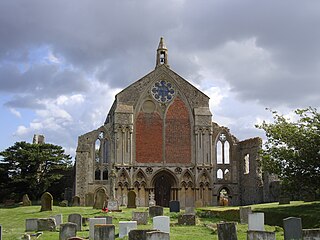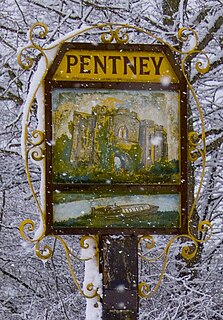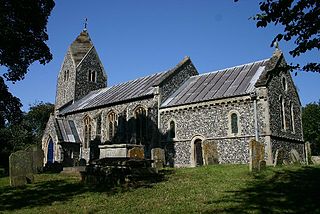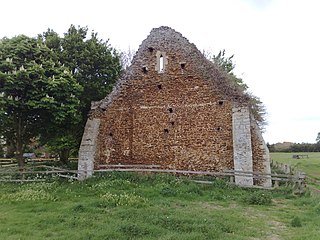Related Research Articles

Ingham is a small village and civil parish in the English county of Norfolk. It lies close to the village of Stalham, and is about 2 miles (3.2 km) from Sea Palling on the North Sea coast.

St Olaves is a village in the English county of Norfolk. The village is situated on the River Waveney, some 6 miles (10 km) south-west of the town of Great Yarmouth and the same distance north-west of the Suffolk town of Lowestoft. It is within The Broads National Park.

Wymondham is a market town and civil parish in the South Norfolk district of Norfolk, England, 9.5 miles (15.3 km) south-west of Norwich off the A11 road to London. The River Tiffey runs through. The parish, one of the largest in Norfolk, includes rural areas to the north and south of the town, including the hamlets of Suton, Silfield, Spooner Row and Wattlefield. It had a population of 14,405 in 2011, of which 13,587 lived in the town.

Thetford is a market town and civil parish in the Breckland district of Norfolk, England. It is on the A11 road between Norwich and London, just east of Thetford Forest. The civil parish, covering an area of 29.55 km2 (11.41 sq mi), has a population of 24,340.
William de Warenne, 1st Earl of Surrey, Lord of Lewes, Seigneur de Varennes, was a Norman nobleman created Earl of Surrey under William II Rufus. He is among the few who are documented as having fought for William the Conqueror at the Battle of Hastings in 1066. At the time of the Domesday Survey, he held extensive lands in 13 counties, including the Rape of Lewes in Sussex, which is now divided between the ceremonial counties of East Sussex and West Sussex.

Castle Acre Priory was a Cluniac priory in the village of Castle Acre, Norfolk, England, dedicated to St Mary, St Peter, and St Paul. It is thought to have been founded in 1089 by William de Warenne, 2nd Earl of Surrey. The order originated from Burgundy. Originally the priory was sited within the walls of Castle Acre Castle, but this proved too small and inconvenient for the monks, hence the priory was relocated to the present site in the castle grounds about one year later.

Binham is a coastal village and a civil parish in the English county of Norfolk. The village is 29.3 miles (47.2 km) north west of Norwich, 16.9 miles (27.2 km) west of Cromer and 124 miles (200 km) north north east of London. The village lies 4.9 miles (7.9 km) east south east of the town of Wells-next-the-Sea.The nearest railway station is at Sheringham for the Bittern Line which runs between Cromer and Norwich. The nearest airport is Norwich International Airport. The civil parish has an area of 11.52 km2 (4.45 sq mi) and in the 2001 census had a population of 273 in 124 households, including Cockthorpe and increasing to 292 at the 2011 Census. For the purposes of local government, the parish falls within the district of North Norfolk.

Thetford Priory is a Cluniac monastic house in Thetford, Norfolk, England. It should not be confused with the Dominican Friary of Blackfriars, Thetford that later became part of Thetford Grammar School.

St Mary's Priory, Binham, or Binham Priory, is a ruined Benedictine priory located in the village of Binham in the English county of Norfolk. Today the nave of the much larger priory church has become the Church of St. Mary and the Holy Cross and is still used as a place of worship. The remains of the priory are in the care of English Heritage. The abbey's west face is the first example in England of gothic bar tracery, predating Westminster Abbey by a decade.

Wereham is a small village and civil parish in the English county of Norfolk.

Weybourne is a village on the coast of North Norfolk, England. The village is surrounded by arable fields, woodland, and heathland and straddles the A149 coast road, three miles west of Sheringham, within the Norfolk Coast AONB. The area is popular for the local countryside and coast and in particular for walking, wildlife, and bird-watching.

Pentney is a village and civil parish in the English county of Norfolk, located about 8 miles (13 km) south east of King's Lynn placing it about halfway between King's Lynn and Swaffham on the A47 road. It covers an area of 10.39 km2 (4.01 sq mi) and had a population of 387 in 184 households at the 2001 census, increasing to 544 at the 2011 Census. For the purposes of local government, it falls within the district of King's Lynn and West Norfolk. It is in the valley of the River Nar, a tributary of the River Great Ouse.
William Barlow was an English Augustinian prior turned bishop of four dioceses, a complex figure of the Protestant Reformation. Aspects of his life await scholarly clarification. Labelled by some a "weathercock reformer", he was in fact a staunch evangelical, an anti-Catholic and collaborator in the Dissolution of the Monasteries and dismantling of church estates; and largely consistent in his approach, apart from an early anti-Lutheran tract and a supposed recantation under Mary I. He was one of the four consecrators and the principal consecrator of Matthew Parker as archbishop of Canterbury in 1559.

Flixton is a village and civil parish located in the district of East Suffolk in the English county of Suffolk. It is located around 2 miles (3.2 km) southwest of Bungay to the south of the River Waveney on the Norfolk border. In 2001 and 2011 the population of the civil parish of Flixton was 176.

Blackborough Priory was a Benedictine monastic house in Norfolk, England, about 5 miles or 8 km south east of King's Lynn. The Ordnance Survey map shows the remains of fishponds nearby, which may have been for the use of the monastery.

The Priory of St Mary de Bello Loco, commonly referred to as Molycourt Priory, was a small Benedictine priory located in the parish of Outwell, Norfolk, England.

Pentney Priory was an Augustinian priory at Pentney in the district of King's Lynn and West Norfolk, Norfolk, England. The ruins of the priory, mostly comprising the flint-built gatehouse, are Grade I listed.

Weybourne Priory was a small Augustinian medieval monastic house in Weybourne, Norfolk, England.
References
- ↑ "Site of Bromehill Priory". heritage.norfolk.gov.uk. Heritage Norfolk. Retrieved 21 May 2020.
| This article about a Norfolk building or structure is a stub. You can help Wikipedia by expanding it. |
| This article about a British Christian monastery, abbey, priory or other religious house is a stub. You can help Wikipedia by expanding it. |